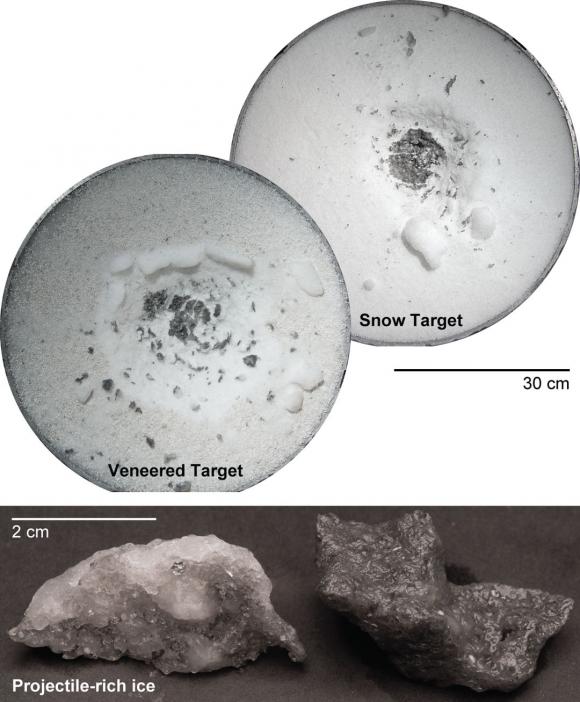
Cosmic flypaper Experiments using a high velocity cannon suggest that when asteroids hit targets that are icy or made of porous silicate materials, much of the impact material stays in the crater. The findings have implications for the surface composition of the dwarf planet Ceres. Image: NASA Ames Research Center
A new set of high-velocity impact experiments suggests projectiles that slamming into Ceres tend to stick. The experiments using Vertical Gun Range at NASA’s Ames Research Center, suggest that when asteroids and other impactors hit Ceres, much of the impact material remains on the surface instead of bouncing off into space. The findings suggest Ceres surface could be mainly a mish-mash of meteoritic material collected over billions of years of bombardment.
Ceres is the largest object in the asteroid belt and the nearest dwarf planet to Earth. Until the recent arrival of the Dawn spacecraft, all that was known about Ceres came from telescopic observations. The observations showed Ceres to be mysteriously low in density, suggesting it is made either of very porous silicate material, or perhaps contains a large layer of water ice.
For porous silicate case, they launched impactors into a powdered pumice. For the icy case, they used 2 targets: snow, and snow covered by a thin veneer of fluffy silicate material, simulating the possibility the Ceres’s ice sits below a silicate layer. They then blasted these targets with pebble-sized bits of basalt and aluminum, simulating both stony and metallic meteorites.
RESULTS: large proportions of the impact material remained in and around the impact crater. This was especially true in the icy case, Daly said. “We show that when you have a vertical impact into snow — an analog for the porous ice we think might be just beneath the surface of Ceres — you can have about 77% of the impactor’s mass stay in or near the crater.”
“This is really contrary to previous estimates for small bodies,” Schultz said. “The thought was that you’d eject more material that you’d collect, but we show you can really deliver a ton of material.” The impact speeds used in the experiments were similar to speeds thought to be common in asteroid belt collisions. The findings suggest that a majority of impacts on porous bodies like Ceres cause an accumulation of impact material on the surface even at asteroid fast speeds.
They are hopeful that as the Dawn spacecraft scans the surface at much higher resolution, it might be able to pick out individual patches of this delivered material. That would help confirm the relevance of these experiments. The results have implications for missions that aim to return asteroid samples to Earth. Unless the landing sites are carefully chosen those missions could end up with samples that aren’t representative of the object’s original material. To get that, it might be necessary to find an area where there has been a relatively recent impact. https://news.brown.edu/articles/2015/10/ceres








Recent Comments